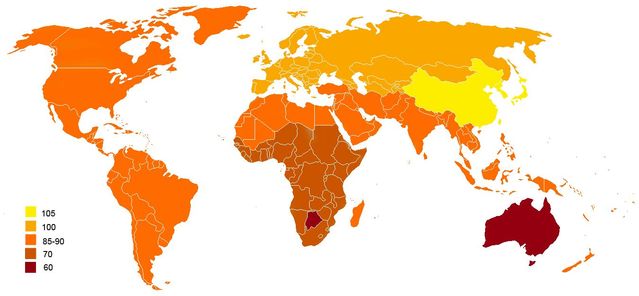Intelligence
Group Differences in IQ: the Diametric Solution
Mentalistic IQ varies inversely with mechanistic IQ in individuals and groups.
Posted September 18, 2012
In the aftermath of World War 2, American soldiers were stationed in Germany, where some inevitably found wives. Black GIs who did so provided the basis of the Eyferth study, which compared 170 children of black GIs with German wives with 69 children of white GI fathers matched for socio-economic status. The IQ of the white fathers' children averaged 97.0, and that of the black fathers’ children, 96.5—in other words, much the same. James Flynn remarks that this finding has “always been an important piece of evidence in favor of genetic equality between black and white Americans,” (p. 88), but it could also be seen as an important piece of evidence in favor of maternal heritability of IQ, given that all the children in the sample had German mothers. And of course, if that is true, then it says nothing about the genetic equality of black and white Americans.

On the contrary, some have claimed that US blacks are about 1 standard deviation lower in IQ scores than whites, while Jews are 0.5-1 standard deviation above whites, the difference mainly verbal but with a notable deficit in visuospatial IQ (pp. 120-2). According to Lynn and Vanhanen’s IQ and the Wealth of Nations, if Europe has an average IQ of 100, that of South Asia, North Africa, and Latin America is 85; sub-Saharan Africa and the Caribbean is 70; and the Orient/Pacific Rim is 105 (map above). Flynn concedes “that Japan’s overall IQ could be anywhere between 101 and 105,” adding that
... there is no dispute: compared to White Americans, Japanese in Japan do strikingly better on nonverbal tests, particularly those emphasizing visuospatial abilities such as visualizing shapes rotated in space, than on verbal tests. Indeed, the nonverbal versus verbal difference may amount to as much as 12 IQ points!
And even this militant environmentalist admits that he suspects that this finding “may have a genetic basis,” and that on tests of visuospatial abilities “Chinese and Japanese Americans may have an advantage that will prove resistant to acculturation,”—even if he immediately goes on to deny that it has any relevance in the modern world (pp. 113-4).
Michael Fitzgerald points out that “African society is very high in social capital, which I suppose goes with emotional intelligence but social capital is low in Western societies.”* If we were to equate such emotional intelligence with what I would call mentalistic IQ, and if we developed effective tests to measure it, would we find that sub-Saharan Africans were about 1 standard deviation above white Europeans? My personal view is that we would, and indeed, that we would find much the same where our great-grandparents were concerned, thereby explaining the other paradox of IQ findings: the Flynn effect.
Indeed, it seems to me patently absurd to claim that Africans, any more than our own ancestors, could be seen as cognitively sub-normal—that is technically, with measured IQ of 70. However, both the Flynn effect and controversial ethnic differences in modern IQs could immediately be explained if we could measure intelligence in the mentalistic as well as in the mechanistic dimension. If so, we might also find that the 12-point superiority of Japanese visuospatial intelligence reflected a strength in mechanistic intelligence comparable to the one seen in high-functioning autistics, whose visuospatial sub-test scores are also often superior to those of non-autistics. The classical syndrome of high-functioning autism, Asperger's, is sometimes called "the engineer's disorder," and looked at this way the astonishing speed and success of Japanese industrialization might immediately make sense—not to mention the striking contrast seen in Africa!
At the very least, snobbery about IQ would vanish if—as would almost certainly be the case—most people found that there mentalistic IQ varied inversely with their mechanistic intelligence. In other words, a higher score on one would mean a lower one on the other. Indeed, if measures of mentalistic and mechanistic cognition were given a positive value in one case and a negative one in the other, normal mentalistic plus mechanistic IQ would equal zero! Only people of real genius might be expected to be different, and even then it would be the standard deviation of their scores that measured it, not necessarily the summed totals.
Where entire ethnic groups were concerned, the modern enthusiasm for celebrating difference rather than insisting on similarity might find its epitome in the realization that there were real cognitive differences between peoples that were of exactly the same kind as those between individuals: some might score higher on mentalistic IQ, but lower on mechanistic measures, and others contrariwise. Indeed, a map of the world illustrating mentalistic IQ differences might be almost identical to one above, but with the values inverted.
And of course, if individual genius is explained by the diametric model as an exceptional extension of intelligence in both dimensions, then the implication is that entire cultures could be similar in their cognitive configurations. Those which had successfully integrated populations with both types of excellence could probably rightly claim it as evidence of their peculiar genius!
* Fitzgerald, M. & Griffin, J. Autistic tendencies: the consequences for our culture. Human Givens 13, 24-9, 2006.




